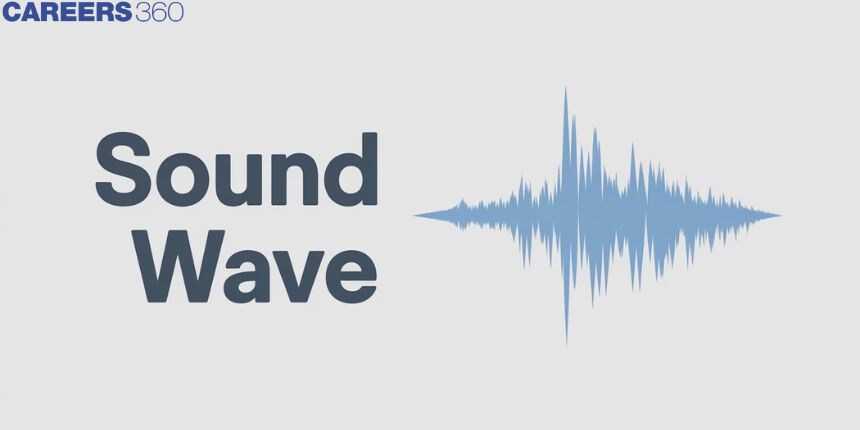Sound Wave
Sound waves are mechanical oscillations moving through a medium such as air, water, or solid materials; they’re created by any object that vibrates and makes the surrounding medium vibrate too. The sound spreads from continuously moving one thing creating regions of high density and low compression behind itself, bringing about a waveform which we hear as noise. In this article, we will discuss the sound waves which are important when studying oscillations, and physics courses that apply to NEET and JEE Main. Most times, understanding sound waves makes it easy to understand other things like wave propagation, frequency and also wavelength. Longitudinal waves are sound waves that transport power.
This Story also Contains
- What is Sound?
- Solved Examples Based on Sound Wave
- Summary

What is Sound?
Sound is a type of energy that travels through a medium, typically air, as a wave. It is produced by the vibration of objects, which causes particles in the surrounding medium to oscillate. These oscillations create regions of compression and rarefaction, forming pressure waves that propagate through the medium. When these waves reach our ears, they are detected by the auditory system and interpreted by the brain as sound.
What is a Sound Wave?
Sound waves always travel through any elastic material medium with a speed that depends on the properties of the medium. As sound waves travel through the air, the molecules of air vibrate to produce changes in density and pressure along the direction of motion of the wave. If the source of the sound waves vibrates as a Sine wave, the pressure variations are also like Sine waves. Because of this, the mathematical description of sinusoidal sound waves is very similar to that of sinusoidal waves on strings.
There are two types of wave
| Transverse waves | Longitudinal waves |
| 1. In this particles of the medium vibrate in a direction perpendicular to the direction of propagation of the wave. | 1. In this particles of a medium vibrate in the direction of wave motion. |
| 2. Transverse waves travel in the form of crests and troughs. | 2. Longitudinal waves travel in the form of compression and rarefaction |
| 3. It can be transmitted through solids, they can be set up on the surface of liquids. But they can not be transmitted into liquids and gases. | 3. It can be transmitted through solids, liquids, and gases because, for this wave propagation, volume elasticity is necessary. |
| 4. Transverse waves can be polarised. | 4. Longitudinal waves can not be polarised. |
Now, as the sound wave travels through the air, the element of air vibrates to produce a change in density and pressure along the direction of motion of the wave. So as we discussed in the table the movement of the sound waves is like compression and rarefaction, this is shown in the given image. The detail of this with an example will be discussed in the latter concept.

Here, $\lambda$ is the wavelength.
R = Rarefaction
C = Compression
Recommended Topic Video
Solved Examples Based on Sound Wave
Example 1: The amplitude of two waves is in a ratio of 5:2. If all other conditions for the two are the same, then what is the ratio of their energy densities?
1) 5:2
2) 10:4
3) 2.5:1
4) 25:4
Solution:
Energy density
So the ratio of energies will be squared of amplitude ratio:
Hence, the answer is the option (4).
Example 2: The following phenomenon cannot be observed for sound pulse
1) Refraction
2) Interference
3) Diffraction
4) Polarisation
Solution:
Pulse
When we flick one end of a long string that is under tension and has its opposite end fixed. In this manner, a single bump is formed and travels along the string this bump is called a pulse.

wherein
Pulse has a defined height and defined speed of propagation along the medium. The shape of the pulse changes very little.
Sound waves are longitudinal in nature so they cannot be polarised.
Hence, the answer is the option (4).
Example 3: A stone dropped from the top of a tower of height 200 m high splashes into the water of a pound near the base of the tower. When is the splash heard at the top? Given that the speed of sound in air is 332 m / s,(g=9.8 m /s2)
1) 1.634
2) 5.267
3) 2.622
4) 3.465
Solution:
Here,
velocity of sound
Let
Then using
or
Also, if
Hence, the answer is the option (3).
Example 4: A vibrating tuning fork of frequency n is placed near the open end of a long cylindrical tube. The tube has a side opening and is also fitted with a movable reflecting Poston. As the piston is moved through 4.65 cm, the intensity of sound changes from a maximum to a minimum. If the speed of sound is

1) 21.5054
2) 23.4506
3) 22.5056
4) 26.4534
Solution:
Hence, the answer is the option (1).
Summary
Sound waves are mechanical vibrations that travel through mediums like air, water, and solids. They are crucial in understanding wave phenomena such as frequency, wavelength, and energy density. Sound waves can be longitudinal, travelling as compressions and rarefactions. The provided examples illustrate key concepts like energy ratios, sound speed calculations, and the inability of sound waves to exhibit polarization, essential for NEET and JEE Main physics.